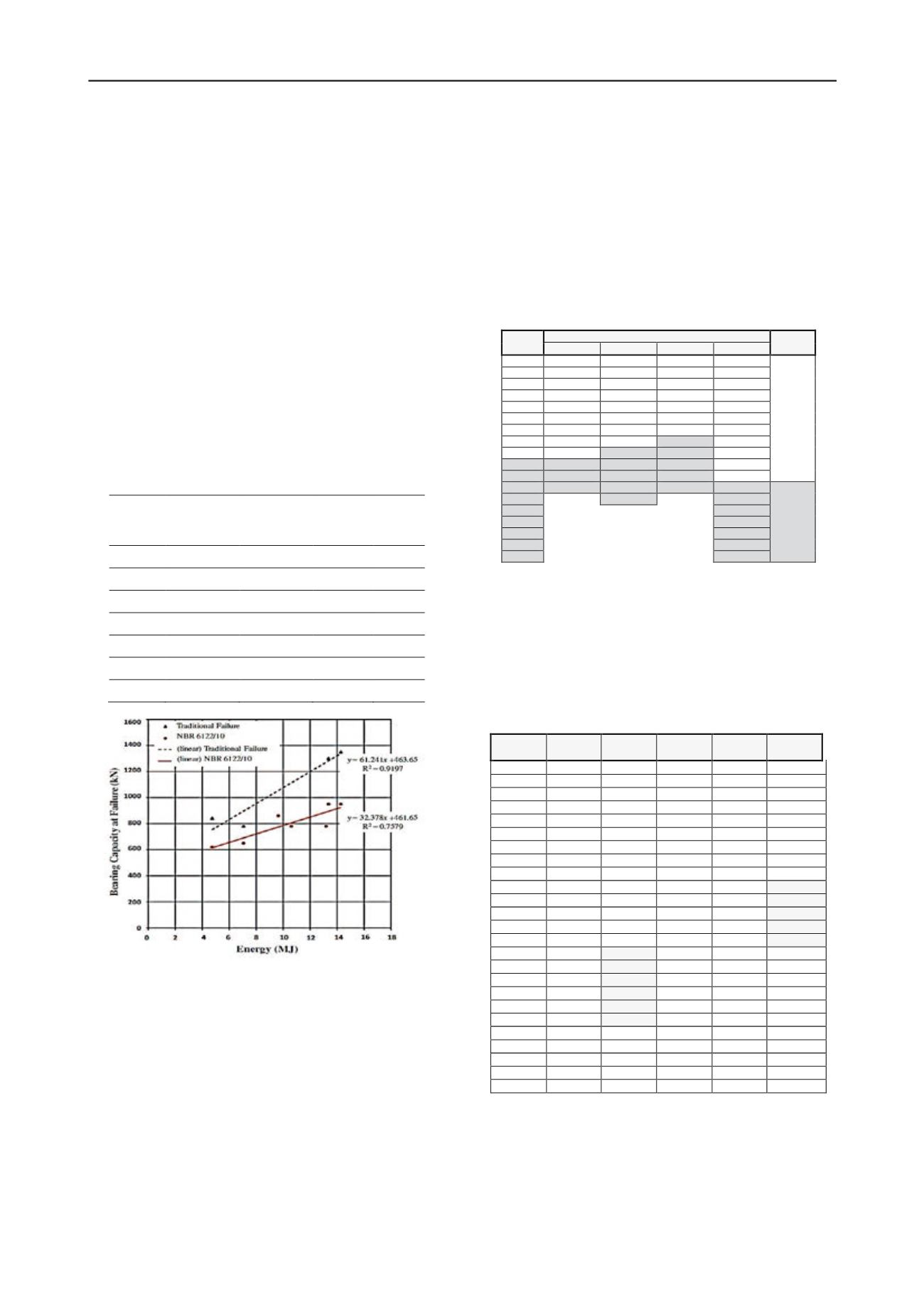
2809
Technical Committee 212 /
Comité technique 212
control in real time and assure to the execution piling process
conditions for the piles to achieve individually the planed
bearing capacity, assuring quality and the design assumptions. It
is very clear that the final behavior of the pile will also depend,
among other issues, for example, the concrete injection pressure
which depending on the type of soil and its value will have a
great influence on the pile behavior, such fact observed by Silva
(2011).
Figure 2 presents the results obtained during the execution
of seven load tests, construction on the Paranoá Lake shore in
Brasília – Brazil and the total required energy to execute each
pile. It can be seen in Figure 2 that the measured energy in each
pile is proportional to its bearing capacity. In Table 1, the most
important geometric and monitored data of the tested piles are
shown. Moreover it’s also observed in Picture 2 that the
ultimate load is rampant with the required energy increase
during the excavation, independently of the failure criteria
adopted, the one from Brazilian norm criterion ( NBR 6122,
ABNT) or the conventional one which corresponds to 10% of
the pile diameter. In this case, all piles were excavated by a
same set machine/operator.
Table 1. geometric features of the piles (modified from silva, 2011).
Pile
Length (m)
Medium
pressure of
concrete
(kPa)
Diameter
(cm)
Total
Energy
(MJ)
E110BA
17,12
100
42
9,64
EPC1BB
15,12
100
42
10,60
TC2BB
12,80
0-75
53
13,18
E55AA
14,24
25-100
37
7,06
EPC1C
10,80
50
42
4,73
GE 24C
20,92
0-50
52
13,36
EE6B
20,08
100
54
14,27
Figure 2. Ultimate bearing capacity versus work done (Silva, 2011).
By the confirmation that the bearing capacity of the pile is
directly proportional to the work done and that the collected
results in the piling (energy) when organized in frequency
distribution conducted to a normal distribution, Silva (2011)
proposed an acceptance for the piles based on Physics concepts
(energy conservation) and on statistics characteristics of
collected energy sample during the execution of the piling.
Preferably they suggested that the population sample would be
collected close to the load test once statistics properties of the
sample could be associated to the real bearing capacity of a pile
in the execution condition adopted in the construction.
According to the authors, if the referred association is not
possible, it is important that the sampling is done in a region
with known geotechnical characteristics, for example, giving
attention to regions where the field tests were executed and have
little variability. Once the region to be sampled was chosen and
its size, the results are put together by class fitting them to a
normalized distribution. By that way, the mean (µ) and the
standard deviation (
σ
), were calculated what made possible to
establish reliability and acceptance criteria to applied in boring.
From the beginning they proposed criteria tht should be chosen
by geotechnical variability basis and the existing quality control
in the construction, for example, it will be accepted the pile
which when achieving the minimum design depth did during
excavation a required and measured work (w) greater than the
mean (µ) of the work measured from the sample (W
≥
µ).
Tabela 2. Caracterização Geotécnica – Ensaio SPT
Deep
(m)
SPT by Layer
Type of
Soil
SPT 01
SPT 02
SPT 03
SPT 04
1
7
6
6
6
Clay
2
4
4
5
5
3
2
4
2
5
4
2
4
4
7
5
4
6
6
10
6
4
6
8
15
7
8
7
4
18
8
7
7
13
13
9
5
11
30
7
10
14
24
30
5
11
32
12
32
9
12
58
31
56
14
Silt
13
52
18
14
21
15
19
16
24
17
27
18
42
In Table 3 the required energies to excavate each pile are
presented. The tip elevations of the pile bases were defined
based on the geotechnical characterization and its location in the
construction site and three different depths were adopted, 10, 11
and 13 m. It is important to mention that the piles were executed
from elevation -4,00m, which is related to the initial elevation
of the borings because of the existence of an underground level.
Table 3. Energia demandada na escavação das estacas (Silva,2011)
Estaca
Prof. (m)
Energia
(MJ)
Estaca
Prof. (m)
Energia
(MJ)
E42A2C
13,12
6,0
E13A2D
13,12
4,7
E23A2F
13,12
6,4
E18A2A
13,12
4,8
E23A2B
13,12
3,9
E25A2C
13,12
4,9
E23A2D
13,36
6,3
E26A2C
13,12
4,3
E18A2E
13,12
5,8
E13A2C
13,12
6,1
E18A2D
13,12
3,6
E13A2B
13,12
8,2
E23A2E
13,12
4,0
E25A2A
13,12
7,5
E23A2C
13,12
4,9
E26A2A
13,12
6,6
E23A2A
13,12
5,8
E13A2A
13,12
5,1
E18A2F
13,60
5,1
E13GA
10,08
3,1
E18A2C
13,12
2,7
E20GB
10,08
3,6
E18A2B
13,12
3,5
E65DC
10,08
3,8
E25A2B
13,12
6,3
E19GB
10,08
5,1
E26A2B
13,12
6,8
E64DC
10,08
3,8
E10GB
10,08
5,1
E2B1E
11,12
8,5
E17GB
10,08
4,3
E11B1A
11,12
6,9
E23G
10,08
2,9
E17B1D
11,12
6,9
E63DB
10,08
2,8
E5B1A
11,12
7,8
E17GC
10,16
4,3
E2B1C
11,12
6,5
E10GC
10,16
4,9
E17B1B
11,12
6,1
E11B1E
13,04
5,6
E5B1B
11,12
5,4
E17B1E
12,96
8,8
E4B1B
11,12
6,7
E17B1A
13,04
6,6
E17B1C
11,12
6,5
E2B1A
11,12
7,6
E2B1D
11,12
6,6
E4B1A
11,12
7,1
E2B1B
11,12
7,2


